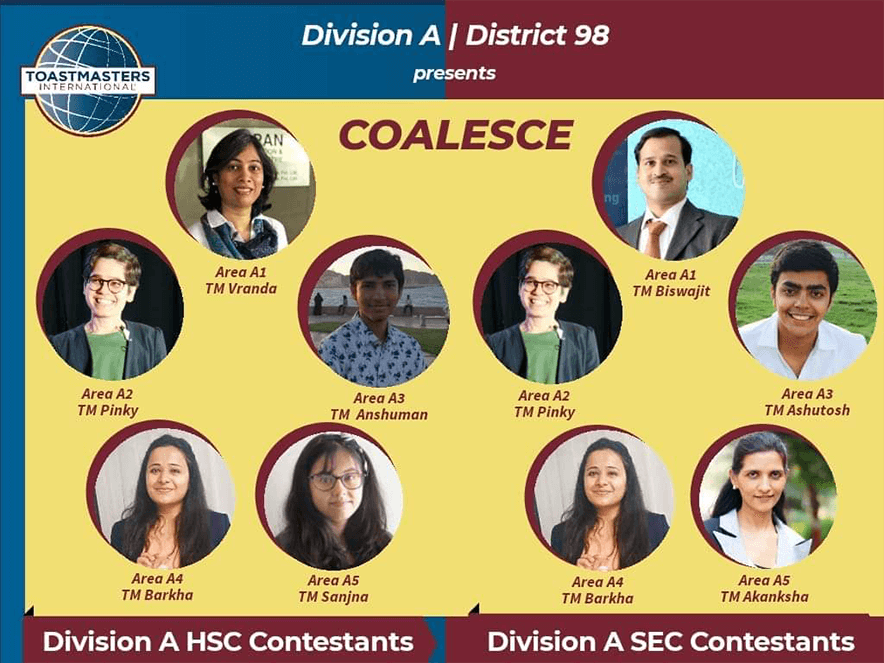
When you think of the Toastmasters International brand, what first comes to mind? The logo? The colors maroon, navy blue, and gray? The club banner?
A brand is all of these things and more. Having a cohesive brand helps people recognize an organization, a product, or even a person. It’s a set of unified elements that shape the perception of that organization, product, or person. It’s also how you communicate your vision to your audience.
“Branding is more than just a random bunch of rules,” says Ilana Herzberg, brand specialist at Toastmasters International. “It brings a cohesiveness to the organization.”
The visual elements are often the most recognizable aspects of an organization or product. Think of a group of restaurants, or a product at a grocery store. There is something similar enough that when you see it, you know what to expect.
While the most recognizable elements of Toastmasters’ branding include the logo and colors, the branding also encompasses the tagline (“Where Leaders Are Made”), the core values (integrity, respect, service, excellence), and even the voice and tone (friendly, professional, and positive).
Everything that a club, Area, District, or region produces—website copy, social media posts, fliers, and contest announcements to name a few—has to follow basic brand guidelines. And all interactions, whether in email, phone calls, or direct conversation, need to convey a clear and warm tone.
Confused as to how to put all of this into action? Toastmasters' Brand Manual and Brand Portal help members and leaders understand the guidelines and quickly find information on colors, fonts, logo usage, and more. They also provide inspiration and marketing ideas.

Why Branding Matters
Herzberg points out that without branding guidelines, Toastmasters would just be a group of clubs, each with their own logo, colors, and approach. Having a strong, recognizable brand means that clubs and members have access to the same support system and a proven education program, as well as an overarching website and the ability to find other clubs.
She uses McDonald’s as an easily understood example of the importance of branding. It’s the same Golden Arches across the world; there isn’t a cowboy hat or Eiffel Tower perched on top. However, restaurants in different regions can customize their menu. In Toastmasters, this works the same way. You can tailor your meetings, but the fundamental elements remain the same.
Having a cohesive brand means that any club you visit around the world, whether online or in person, will have the same meeting elements. There will be a Toastmaster of the Day, speeches will follow the Pathways learning experience, and Table Topics® will be intimidating.
Put the Brand Into Action
For some Toastmasters leaders, understanding brand guidelines will be their first encounter with branding, while other officers and leaders may have years of experience. The Brand Manual breaks down the disparity and makes it possible for all clubs and Districts to produce the same polished products.
One of the most common assumptions Herzberg hears is “If I don’t use the logo then I don’t have to adhere to the brand guidelines.” This is not the case, she explains. It’s not the logo alone that makes the brand. “Every material, brochure, web post, and invitation is a representation of the brand, regardless of whether it has the logo or not. It still needs the right colors, fonts, pictures, and tone.”
Having a cohesive brand is what allows people from around the world to recognize the name Toastmasters.
As long as you’re creating paper or online promotional materials (with the exception of certificates), if you are following the Toastmasters Brand Manual, you don’t need approval from World Headquarters. However, products such as apparel, accessories, videos, and websites need to get approval through a Trademark Use Request form before you purchase or produce them. And some materials (acrylic name badges, ribbons, pins, and club banners) cannot be either designed or produced locally—they must be obtained through Toastmasters International. This is not only for brand compliance but also for award and recognition consistency.
Trademarks are particularly important for nonprofit organizations. “Any material that could merely suggest a partnership that could potentially be profitable threatens our nonprofit status,” explains Herzberg.
For this reason, clubs cannot partner officially with other fundraisers. Even a simple walk-a-thon or hospital fundraiser can be problematic. The Toastmasters logo or name might appear on apparel or fliers alongside more controversial or polarizing organizations.
Rising to the Challenge
The first time Shruti Shivhare became aware of the Toastmasters brand guidelines was in July 2020, when she took on the role of Division PR Focal (a position on the District 98, Division A PR team). At the time, most club members in her Division perceived the guidelines as a restriction and an obstacle to their creativity. However, she was determined to challenge herself and inspire other members by showing what you could do within the guidelines.
She started designing brand-compliant fliers, posters, animations, and videos for Division-level events. “To my surprise, the work started to create an impact, and the materials got appreciated all over the District,” Shivhare says.
She soon realized that rather than looking at the guidelines as a hinderance, the limited options actually increased her level of creativity. She began working with a team to conduct sessions and workshops to familiarize club officers with brand guidelines and help them adapt. “It was a great opportunity to challenge ourselves and put our skills to the test,” she says.
Shivhare also notes that facing challenges is what helps people realize their true potential. “All the guidelines, which seemed to be obstacles at first, were an opportunity to upgrade my skills, and it’s been my pleasure to not only use them constructively but also to bring change to the perspective of others.”
Trisha “Trixie” Hunter-Merrill, DTM, of Eloquent Entrepreneurs in Greenwood Village, Colorado, also embraces the brand guidelines of Toastmasters. “Think of it this way,” she says, “if you have your own business or you’re a star, you have a brand, and you want to protect that brand. If you did all this work to build up that brand, you wouldn’t want somebody else changing the colors and fonts and doing things outside of what your brand is.”
Take the opportunity to learn more about branding—expand your skill set, challenge yourself to work within guidelines, and embrace the possibilities.



 Previous
Previous
 Resources
Resources
 Previous Article
Previous Article

